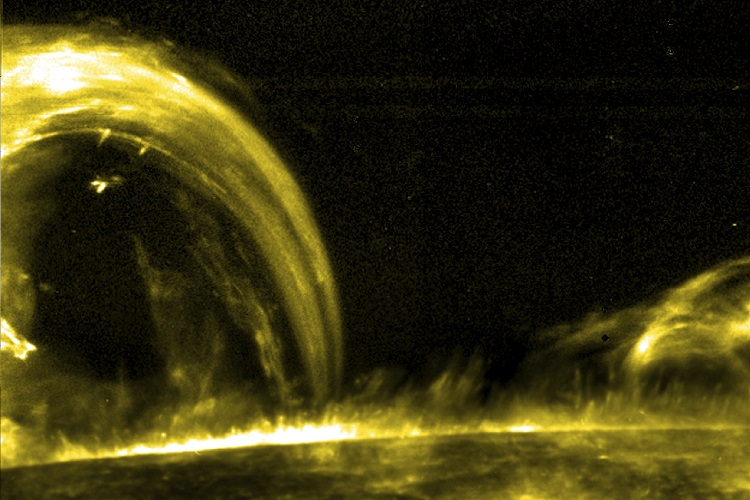
An international team of scientists led by the universities of Northumbria and St Andrews with the National Aeronautics and Space Administration (NASA) has discovered new activity within the Sun's atmosphere which could explain how it reaches temperatures of more than a million degrees.
The solar corona is the outermost part of the Sun's atmosphere but is hundreds of times hotter than the star's surface - a mystery which has baffled astronomers and physicists for decades.
The new, ground-breaking research, published in Nature Astronomy (Monday 21 September), has, for the first time, found direct evidence that the reconnection of magnetic field lines within the corona results in characteristic bursts of energy which could account for its high temperature.
The surface of the Sun is covered in magnetic fields full of charged particles which form striking features such as coronal loops. These loops connect to the dynamic Sun's surface, keeping the magnetic lines constantly charged with energy.
Sometimes the field lines become tangled and 'braided' together, but then separate and snap back into smoothened lines in a process known as 'reconnection'. When this happens, a sudden burst of energy occurs known as a 'nanoflare'. The researchers realised that this process is accompanied by the heated gas moving sideways very quickly between the two lines, creating a 'nanojet'.
Nanoflare-like bursts of energy have been observed for the last ten years but never directly connected to coronal heating as the physical origin of small bursts of energy can be manifold.
Now a team of researchers, led by Dr Patrick Antolin of Northumbria University, in collaboration with academics from the University of St Andrews, the Harvard-Smithsonian Center for Astrophysics in the US, Palermo Astronomical Observatory and Palermo University in Italy, have, for the first time been able to detect nanojets alongside nanoflares during a heating episode of the corona, thereby directly identifying magnetic reconnection as the heating mechanism.
The research team used data and footage from NASA's Interface Region Imaging Spectrograph (IRIS) telescope which provided the high-resolution images needed to prove their theory. Using footage and images from the telescope, they identified and analysed a nanojet storm, tracking the impact this had on the temperature of the corona.
Speaking about the research, project lead Dr Antolin said: "Misaligned magnetic field lines can break and reconnect, producing nanoflares in avalanche-like processes. However, no direct and unique observations of such nanoflares existed to date, and the lack of a smoking gun had cast doubt on the possibility of solving the coronal heating problem.
"From coordinated multi-band high-resolution observations we discovered evidence of very fast and explosive nanojets, the tell-tale signature of reconnection-based nanoflares resulting in coronal heating.
"Using state-of-the-art numerical simulations, we have demonstrated that the nanojet is a consequence of the slingshot effect from the magnetically tensed, curved magnetic field lines reconnecting at small angles. Nanojets are therefore the key signature to look for reconnection-based coronal heating in action."
The storm observed by the team lasted around 15 minutes. During that time the area of the corona under observation went from being filled with cool plasma to being heated to up to millions of degrees. The exact conditions which lead to the occurrence of such a nanojet storm are still not clear, however, it is believed the amount of cool plasma within the coronal loop may be partly responsible.
One of the biggest challenges in discovering more about the heating of the corona is accurately monitoring exactly what is going on within the Sun's atmosphere - which is around 86.5 million miles from earth.
Dr Paolo Pagano, from the Solar and Magnetospheric Theory Group at the University of St Andrews, said: "In St Andrews we focused on the explanation and modelling of the observed nanojets. Using state-of-the-art magnetohydrodynamic codes and high-performance computing infrastructures, we could reproduce the dynamics of the magnetic reconnection in the solar corona and the following nanojets with computer simulations.
"Our computer simulations describe in detail the dynamics of two misaligned magnetic field lines systems and how these undergo reconnection. As a result, a small energy burst occurs, the nanoflare, and the plasma is ejected sideways, the nanojet.
"For decades scientists have tried to demonstrate that nanoflares are behind the million-degree solar corona and to simulate these observed nanojets and heating in terms of the magnetic reconnection has been crucial in linking these observations to nanoflares.
Dr Pagano added: "It should be emphasised that the solar corona is a very dynamic environment, where magnetic fields are continuously generated and disrupted releasing energy to maintain the million degrees corona as we explained in this work, but also triggering other phenomena, such as solar eruptions. Computer simulations have become an essential tool to understand the physics of the solar corona."
The paper 'Reconnection Nanojets in the Solar Corona' has been published in Nature Astronomy' is published in Nature Astronomy and is available online.
Please ensure that the paper's DOI (dx.doi.org/10.1038/s41550-020-1199-8) is included in all online stories and social media posts, and that Nature Astronomy is credited as the source.
The Solar and Magnetospheric Theory Group at the University of St Andrews has a long tradition in the modelling of the solar corona using computer simulations and this research has been made possible by the European Research Council who financed the CORONALDOLLS project aimed at modelling the mechanisms behind the coronal heating with 3D computer simulations.
Dr Antolin is an STFC Ernest Rutherford Fellow and member of Northumbria University's world-class Solar Physics Research Group, which uses mathematical techniques and cutting-edge computer simulations, as well as the latest high-resolution data from international ground-based and spaced-based instruments, to study dynamical events occurring in the solar atmosphere.






